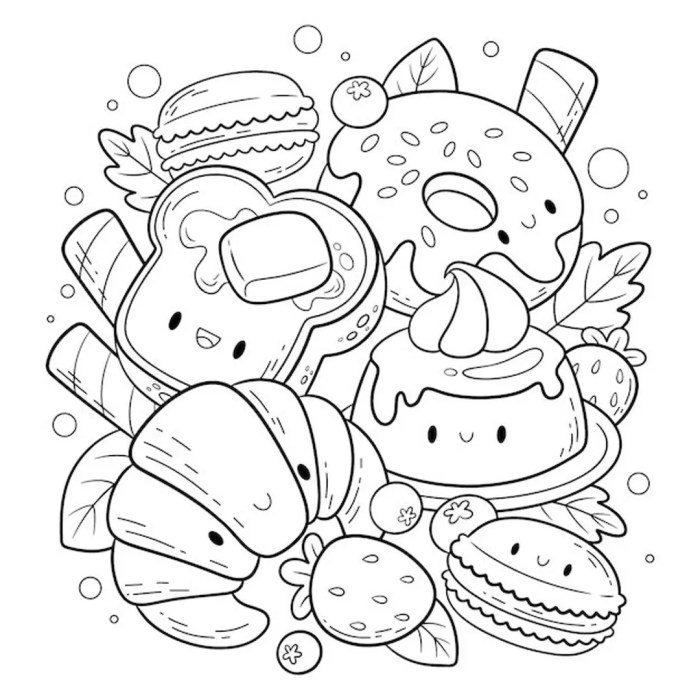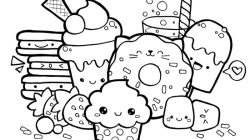Target Audience Definition

Shades of kawaii coloring book – This coloring book, “Shades of Kawaii,” targets a specific demographic with a keen interest in cute aesthetics and creative expression. Understanding this target audience is crucial for effective marketing and design choices. The following sections detail the key characteristics of our ideal user.
The primary age range for this coloring book is 8-16 years old, encompassing late childhood and early adolescence. This age group is particularly receptive to kawaii culture and enjoys engaging in creative activities that foster self-expression and relaxation.
Personality Traits and Interests
The ideal user of “Shades of Kawaii” possesses a personality that appreciates cuteness, detail, and creativity. They are likely to enjoy activities such as drawing, crafting, and collecting cute items. They are often imaginative, detail-oriented, and appreciate aesthetically pleasing designs. Many will also be active on social media platforms, sharing their creations and engaging with online communities centered around art and kawaii culture.
Their interests extend beyond coloring; they might also enjoy anime, manga, fashion, and other forms of creative expression.
Emotional Responses
This coloring book is designed to evoke positive emotional responses in its users. The calming nature of coloring, combined with the appealing kawaii imagery, can help reduce stress and anxiety. The act of completing a page can instill a sense of accomplishment and pride. The book aims to foster feelings of joy, relaxation, and self-satisfaction. Furthermore, the sharing of completed pages with friends or online communities can contribute to feelings of connection and belonging.
Buyer Persona: Meet Maya
To further illustrate our target audience, we have developed a buyer persona: Maya is a 12-year-old girl living in a suburban area. She is a bright and creative student who enjoys art class and spending time with her friends. Maya is highly active on social media, particularly Instagram and TikTok, where she shares her artwork and follows accounts dedicated to kawaii culture.
She values self-expression and enjoys activities that allow her to showcase her creativity. Maya appreciates cute and pastel-colored items and often incorporates kawaii elements into her personal style. She is likely to purchase this coloring book based on its appealing cover art and the promise of hours of creative fun. Her parents might purchase it for her as a gift, recognizing its potential to be both entertaining and relaxing.
Kawaii Style Exploration: Shades Of Kawaii Coloring Book

The “kawaii” aesthetic, originating in Japan, translates roughly to “cute” or “adorable.” It’s a multifaceted style characterized by its emphasis on childlike innocence, playfulness, and a general sense of sweetness. Understanding its core elements is crucial for designing a successful kawaii coloring book that resonates with its target audience.The core elements of kawaii are intertwined and often work synergistically to create the overall effect.
These include the use of simplified features, large eyes, pastel color palettes, rounded shapes, and a generally soft and gentle visual language. The effect is one of endearing innocence and appeal, often evoking feelings of warmth and happiness.
Kawaii Sub-styles, Shades of kawaii coloring book
Various sub-styles exist within the broader kawaii umbrella, each with its own nuances and appeal. These sub-styles offer diverse options for a coloring book, allowing for a varied and engaging experience.
- Cute Animals: This is arguably the most recognizable kawaii sub-style, featuring animals with exaggerated features like large, expressive eyes, small noses, and rounded bodies. Think of cartoonish depictions of bunnies, kittens, pandas, and other animals commonly associated with cuteness.
- Pastel Colors: Soft, muted hues like pink, blue, lavender, mint green, and peach are integral to the kawaii aesthetic. These colors contribute to the overall feeling of gentleness and sweetness.
- Sanrio Style: Inspired by the Sanrio company (Hello Kitty, My Melody), this style emphasizes simple, rounded shapes, bright colors, and characters with friendly, approachable expressions. The designs are often whimsical and playful.
- Food Kawaii: This sub-style features cute depictions of food items, often with anthropomorphic qualities or playful designs. Think of smiling cupcakes, happy strawberries, or kawaii-fied sushi.
- Character Kawaii: This broad category encompasses a wide range of characters, often with unique personalities and backstories. These characters can be animals, humans, or fantastical creatures, each designed with distinct kawaii features.
Comparison of Kawaii Styles for Coloring Books
Different kawaii styles offer varying levels of complexity and appeal for coloring. For example, the Sanrio style, with its relatively simple shapes and bright colors, might be more suitable for younger children, while a more intricate character kawaii design could appeal to older audiences. A coloring book could successfully incorporate several of these sub-styles to cater to a broader range of preferences.
The cute animal style, due to its universal appeal and ease of depiction, is a strong foundation for any kawaii coloring book. The pastel color palette complements almost any kawaii sub-style, enhancing the overall feeling of sweetness and charm.
Kawaii Mood Board Visual Description
Imagine a mood board featuring several distinct sections. One section showcases a collage of cute animals: a fluffy bunny with oversized eyes and a rosy nose, a playful kitten with a mischievous grin, and a panda with round, black eyes and a chubby body. These images are rendered in soft pastel shades of pink, blue, and lavender. Another section displays examples of food kawaii: a smiling cupcake with sprinkles, a strawberry with happy eyes and a smiling mouth, and a piece of sushi with a cute face.
These are presented in a bright, cheerful palette. Finally, a section dedicated to character kawaii shows a collection of diverse characters, each possessing distinct personalities and kawaii features, displayed against a backdrop of soft pastel hues. The overall mood is one of lightheartedness, playfulness, and undeniable charm. The board’s layout is deliberately varied to showcase the diversity within the kawaii aesthetic while maintaining a cohesive and visually appealing presentation.
Shades of Kawaii coloring books offer a delightful way to explore the cute aesthetic. If you’re looking for more options beyond physical books, consider exploring the vast selection available through free coloring book apps, such as those found on this helpful resource: free coloring book apps. Many of these apps feature similar adorable themes, allowing you to continue your kawaii coloring journey digitally and discover new artistic avenues.
The convenience and variety offered by these apps perfectly complement the charm of shades of kawaii coloring books.










